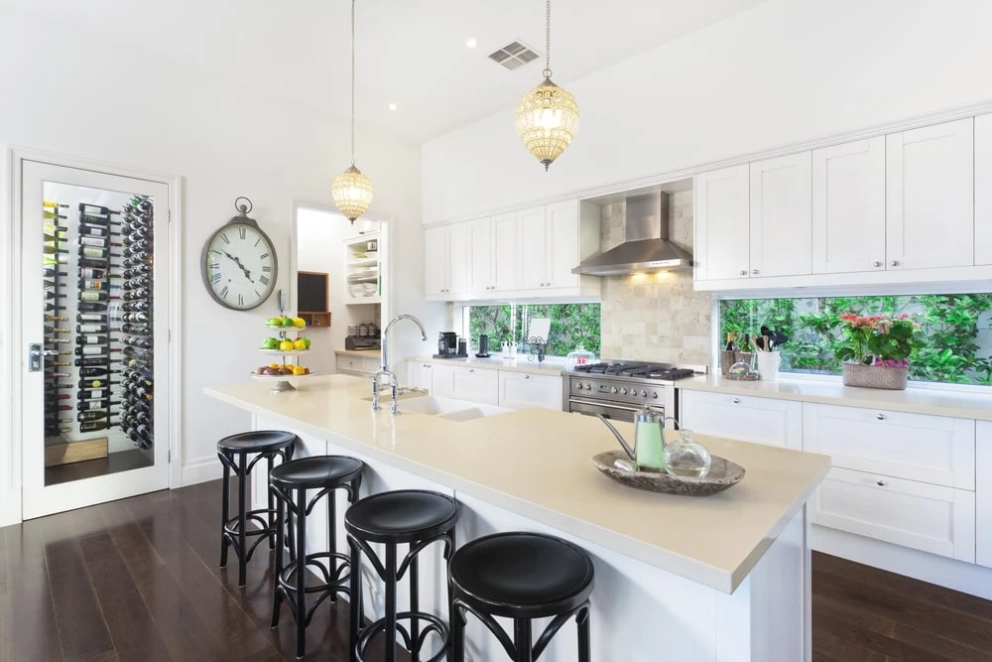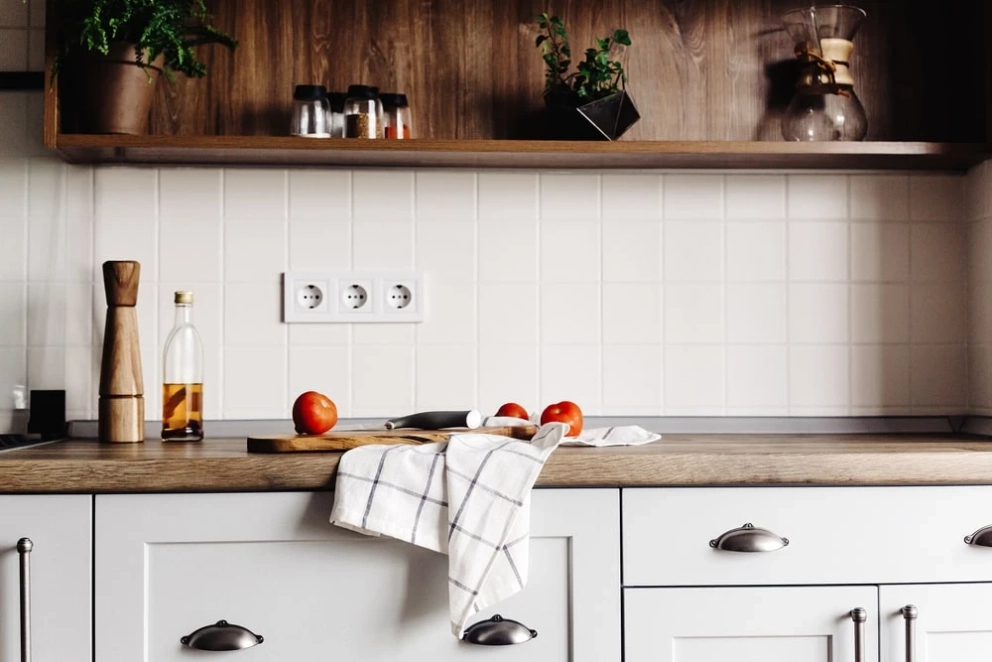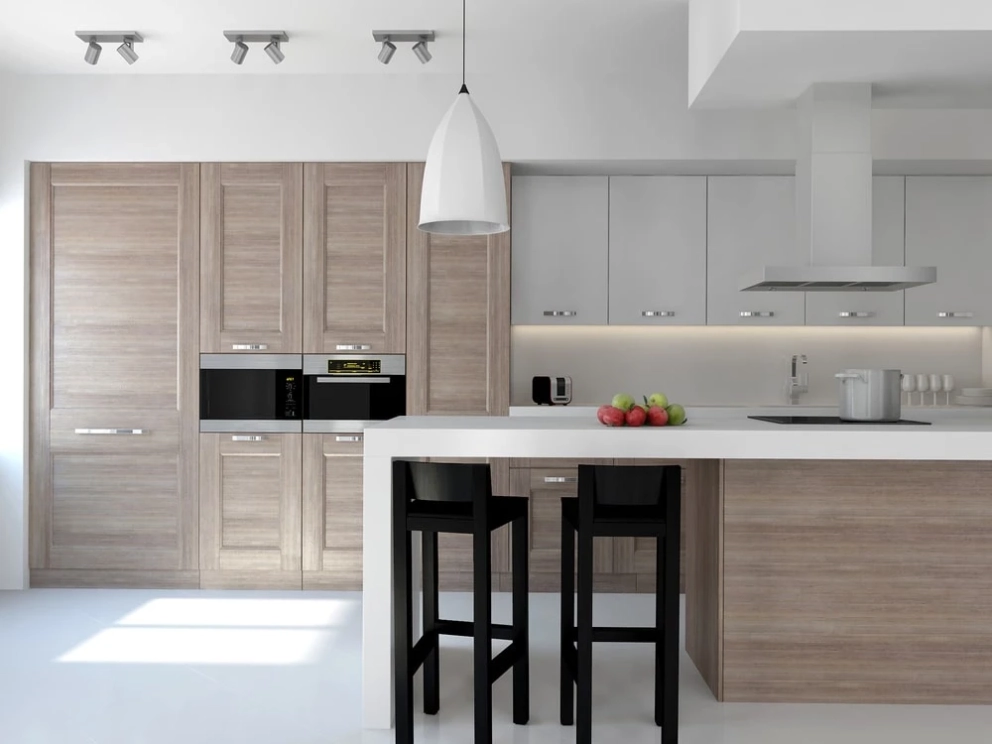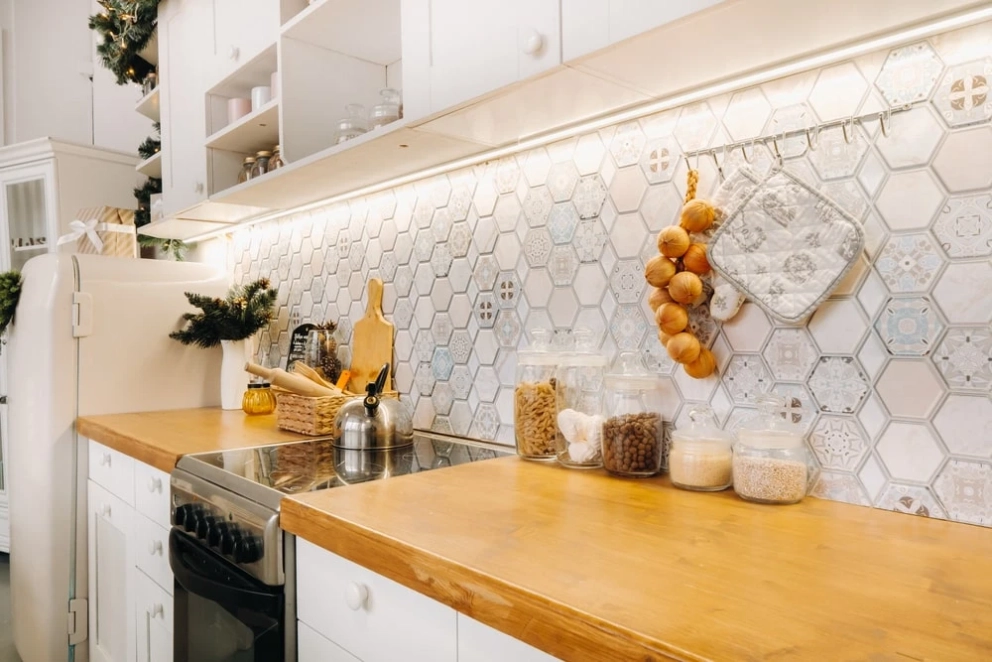What is a transitional kitchen? Discover the beauty of transitional style for your kitchen

Transitional kitchens are considered by interior designers as one of the most timeless kitchen designs. However, most homeowners are not quite familiar with this style. Some mistook a transitional modern kitchen as contemporary or mid-century modern. These styles do have something in common. However, a modern transitional kitchen has distinct design features that distinguish it from other kitchen interior design styles.
Transitional kitchen designs are common in open-concept kitchens or kitchens with large floor space. Interior designers can utilize the big area to stylize the space with contemporary furniture, blending it seamlessly with traditional design features. In today’s era, however, kitchen design approaches alike become more and more strategic with incorporating techniques even in the smallest of spaces, a small transitional kitchen is deemed possible.
Equipped with the right knowledge, creativity, and love for interior design, knowing the right materials, and being backed with expert advice and guidance, creating a transitional kitchen in small spaces is doable. In this blog, we will discuss the different transitional kitchen ideas, what are the different transitional kitchen styling, and how to incorporate features like transitional kitchen cabinetry, kitchen island, and kitchen backsplash. Let’s dive right in!
Transitional kitchen design features

Designing a transitional kitchen is all about striking the right balance between classic and contemporary elements. From furniture choices to layout considerations and lighting fixtures, every decision plays a crucial role in achieving the desired aesthetic. In this section, we'll explore the key aspects of transitional kitchen designs, including the right furniture, layout options, and lighting fixtures that bring this style to life. So let's dive in and discover how to create a harmonious kitchen design transitional that seamlessly blends the best of both worlds!
Furniture choices
When it comes to selecting furniture for your modern transitional kitchen design, focus on pieces that embody both classic and modern design elements. Opt for clean lines and understated details that offer a timeless appeal. Consider incorporating furniture with a mix of materials, such as wood and metal or glass and chrome, to create an interesting visual contrast.
Choose chairs and stools with upholstered seats in neutral tones or subtle patterns to add comfort and texture to the space. When it comes to tables, a sleek and versatile design in a complementary finish will tie the room together.
Layout considerations
One popular layout option that suits transitional kitchens is the transitional galley kitchen layout. This design maximizes efficiency and functionality while offering a balanced aesthetic. A galley kitchen features parallel countertops and cabinetry on opposite walls, creating a streamlined and organized workspace.
To enhance the transitional style, consider selecting shaker-style or flat-panel cabinets with clean, straight lines. Opt for neutral or light-coloured cabinetry to maintain a bright and airy feel. Incorporate a mix of open shelving and closed cabinets for storage versatility, ensuring that the space remains clutter-free. By embracing the galley kitchen layout, you can create a harmonious transitional space that is both practical and visually pleasing.
Transitional kitchen lighting
The right transitional lighting for the kitchen can make or break the overall atmosphere of your transitional kitchen. In addition to ambient and work lights, pendant lights are an excellent choice for adding warmth, style, and functional illumination to the space. Opt for transitional kitchen pendants with clean lines and a blend of materials, such as glass and metal or fabric and metal, to maintain the transitional aesthetic. Hang them above the kitchen island or dining area to create a focal point and enhance the visual appeal.
Consider choosing pendant lights with adjustable heights to accommodate different activities, from food preparation to entertaining guests. The soft, warm glow emitted by pendant lights will create a cozy ambiance that complements the transitional style.
Remember, in a transitional kitchen, it's all about finding the perfect harmony between classic and contemporary elements. The furniture you choose should strike a balance between timeless appeal and modern flair. The galley kitchen layout maximizes efficiency while offering a streamlined design. Lastly, pendant lights add a touch of elegance and functionality, creating a cozy and inviting atmosphere. By carefully considering these key aspects, you'll be well on your way to designing a stunning transitional kitchen that seamlessly combines the best of both worlds.
Transitional kitchen colour ideas

In this section, we'll explore various transitional kitchen styles and colours, providing insightful tips on how to style each one to achieve the perfect balance between classic and modern. So let's dive in and discover the charm of transitional kitchens!
- Transitional white kitchen
A white transitional kitchen exudes timeless elegance and creates a soothing atmosphere. The key to achieving this style is by combining classic design elements with modern touches. Opt for white cabinetry, adorned with simple and sleek hardware for a minimalist look.
Incorporate natural materials like marble or quartz countertops to add a touch of luxury. Complement the white backdrop with stainless steel appliances and light fixtures to create a seamless, cohesive design. Accessorize with hints of muted colours or textures to prevent the space from feeling sterile and to add warmth and character. - Brown transitional kitchen
For those seeking a warmer and earthier colour scheme, a brown transitional kitchen offers a cozy and inviting atmosphere. Opt for rich, dark wood cabinetry paired with lighter countertops to strike a balance. Use subway tiles or stone backsplashes to add texture and visual interest to the space.
To enhance the transitional aesthetic, select stainless steel appliances or brushed nickel hardware to complement the warm tones. Consider incorporating pendant lights with warm light bulbs to create an inviting ambiance. Accessorize with colourful accents, such as vibrant kitchen utensils or fresh plants, to add a pop of life to the design. - Two-tone transitional kitchen
The two-tone transitional kitchen embraces the beauty of contrasting colours to create a visually captivating space. Experiment with two complementary colours, such as navy blue and white, gray and beige, or even black and wood tones. Paint the upper cabinets in one colour and the lower cabinets in another to achieve a harmonious balance. You can also use different colours for the kitchen island or hutch cabinet.
Choose hardware that complements both colours and maintains a cohesive design. Balance the boldness of the two-tone scheme by incorporating neutral countertops and light fixtures. This style allows you to unleash your creativity while maintaining a transitional charm. - Black and white transitional kitchen
A black-and-white transitional kitchen combines the timeless elegance of white with the striking drama of black. Start by painting the cabinets white or opting for white cabinetry with black countertops. Introduce black accents through light fixtures, hardware, or a statement backsplash.
This contrasting colour combination creates a visually stunning effect that is both classic and contemporary. Incorporate open shelving or glass-front cabinets to display monochromatic dishware or bold-colored accessories. To prevent the space from feeling too monotonous, add pops of colour through vibrant kitchen textiles or fresh flowers.
Transitional kitchen cabinetry

In this section, we'll explore the characteristics and design considerations for transitional-style kitchen cabinets, helping you make informed choices that will bring your vision to life. So, let's delve into the world of transitional kitchen cabinets and unlock the secrets to achieving the perfect balance.
- Classic silhouettes with a modern twist
Transitional kitchen cabinet often features classic silhouettes with clean lines and subtle detailing. Shaker-style cabinets, with their recessed panels and simple yet elegant frames, are a popular choice for achieving a transitional look. These cabinets offer a versatile canvas that can be adapted to suit both traditional and contemporary aesthetics. Consider selecting cabinets with square or bevelled edges, as they strike the perfect balance between refined elegance and modern simplicity. - Neutral colour palette
To maintain the kitchen cabinets transitional style aesthetic, opt for a neutral colour palette for your cabinetry. Classic white cabinets continue to be a timeless choice, providing a bright and airy ambiance. Shades of gray, beige, and cream are also popular, offering a warm and inviting atmosphere. These neutral hues create a backdrop that allows other design elements, such as countertops, backsplashes, and hardware, to shine. The versatility of a neutral colour palette ensures that your cabinetry will remain timeless as trends evolve. - Mixing materials
Incorporating a mix of materials in your cabinetry can add visual interest and depth to your transitional cabinets for the kitchen. For example, consider combining wood cabinets with glass-fronted or open shelving to introduce a touch of modernity. Glass inserts can showcase elegant dishware or decorative items, while open shelving provides an opportunity to display curated collections. Integrating metal accents, such as stainless steel or brushed nickel hardware, adds a contemporary touch that complements the classic cabinetry. - Functionality and organization
Transitional kitchen cabinetry prioritizes both style and functionality. Optimize your storage options by incorporating features such as pull-out drawers, built-in spice racks, or specialized compartments for pots and pans in your transitional kitchen pantry. Consider incorporating soft-close mechanisms for a luxurious and quiet experience. The goal is to create a clutter-free and well-organized space that seamlessly combines form and function. - Lighting and glass details
Transitional kitchen cabinetry can be enhanced with thoughtful lighting and glass details. Install under-cabinet valance with lighting to illuminate your countertops and create a warm and inviting atmosphere. Glass cabinet doors or inserts can be used to showcase cherished dishware or add a touch of elegance. Frosted or seeded glass can strike a balance between transparency and privacy, allowing for a glimpse of what lies within while adding a subtle visual texture.
Transitional kitchen with island

The kitchen island serves as the centrepiece of any kitchen, and in a transitional design, it offers an excellent opportunity to blend classic and contemporary elements. A transitional kitchen island should be both functional and visually appealing, seamlessly integrating into the overall aesthetic. Here are some key considerations when designing a transitional kitchen island:
- Strive for a balanced design by combining classic and modern features. Consider a classic panel design for the island cabinetry, such as recessed or Shaker-style doors, paired with clean lines and minimalistic hardware for a touch of modernity.
- Experiment with contrasting finishes to add visual interest. For instance, if your main cabinetry is in a light colour, opt for a darker or contrasting finish for the island. This creates a focal point while maintaining a cohesive transitional look.
- Incorporate practical features into your kitchen island to enhance its functionality. Consider adding a built-in cooktop, sink, or wine fridge, depending on your needs. This ensures that the island becomes a versatile workspace where cooking, food preparation, and entertaining seamlessly converge.
- Just like with cabinetry, mixing materials can add depth and texture to your kitchen island. Consider incorporating a combination of wood, stone, or quartz countertops, and metal accents such as stainless steel or brushed nickel for a contemporary touch.
- Provide ample seating options around the kitchen island to create a gathering space for family and guests. Choose transitional kitchen bar stools or chairs that match the overall transitional style, incorporating materials like wood, metal, or upholstery that complement the island's design.
Transitional kitchen backsplash
The backsplash is an essential element in any kitchen design, and in a transitional kitchen, it presents an opportunity to infuse character and style. There are many transitional kitchen backsplash ideas you can find on the internet. What you choose depends entirely on your design choice and preferences, but here's how you can create striking transitional kitchen backsplashes:
- Select a tile that strikes a balance between traditional and contemporary aesthetics. Subway tiles, with their timeless appeal, are an excellent choice. Opt for larger tiles or unique shapes like hexagons to add a modern twist. Consider using natural stone, glass, or ceramic tiles to add texture and visual interest.
- Play with patterns and layouts to create visual impact. Herringbone, chevron, or vertical stack patterns can add a touch of sophistication and movement. Alternatively, a classic brick pattern can provide a timeless backdrop for your kitchen.
- Choose a colour palette that complements the overall transitional design. Neutral tones like whites, creams, grays, or beiges create a timeless and versatile backdrop. You can also introduce subtle pops of colour through accent tiles or a mosaic design to add personality without overwhelming the space.
- Consider incorporating metal accents into your backsplash design to add a contemporary touch. Stainless steel or brushed nickel inserts or borders can create a sleek and modern look while maintaining the transitional aesthetic.
- Add visual interest by incorporating textured or detailed tiles into the backsplash design. Subway tiles with bevelled edges or textured patterns can create depth and dimension. Consider incorporating decorative tiles as focal points or border details to infuse a touch of elegance.

Transitional kitchen hardware
In the realm of kitchen design, it's often the little details that make the most significant impact. When it comes to creating a transitional kitchen, one crucial aspect that should not be overlooked is the selection of hardware. Here are some of the transitional kitchen cabinet hardware that would look great in a transitional kitchen.
| Hardware styles | Description |
| Shaker-style pulls | Simple, clean lines with a recessed grip; timeless and versatile |
| Brushed nickel knobs | Sleek and modern it adds a touch of sophistication to the cabinetry. |
| Glass or crystal | Elegant and transitional and provides a subtle hint of glamour. |
| Stainless steel bar | Contemporary and sleek and adds a modern touch to a transitional style. |
| Brass cup pulls | Vintage-inspired; offer a traditional yet transitional charm. |
| Flat black handles | Bold and dramatic and creates a striking contrast in a white kitchen. |
| Chrome finger pulls | Minimalist and sleek. It blends seamlessly with a transitional design. |
| Oil-rubbed bronze | Warm and rustic and adds a touch of old-world charm to the kitchen. |

